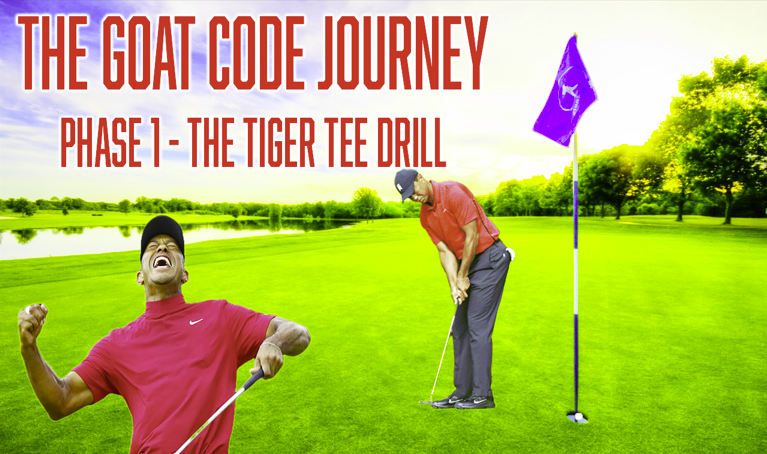Video Transcription: Proper Pitch Shot Technique
For a full swing, one of the most important things you're trying to do is have a lot of shaft lean so that you can take loft off the club and hit the ball first - come down with a descending blow - which helps you compress the ball properly and launch it on a proper angle with less loft than the club has, normally, and you're trying to build a lot of power in the swing.
In a pitch shot, you don't want any of those things. You don't want power, you need finesse and control. And you want spin, so taking a lot of loft off the club doesn't make a lot of sense.
That's why a lot of golfers who go to a lot of short game schools, they're taught all the same basic, extremely limited and very poor way of hitting a pitch shot, which is to play the ball way back in their stance, put all the weight on their front foot, get a lot of shaft lean at address, and then don't use their hands. They just kind of hit this little hold shot.
All that's doing is it's taking my 60° wedge and making it a 45° wedge so I have way less loft at impact, so it's basically impossible for me to put a lot of spin on the ball unless I hit it really, really hard, which obviously you don't want to do on a short shot.
You need to understand that there are differences between those two requirements. One says I need to put a lot of spin on it, and one says I need to take spin off. You don't want to hit your 7 iron with a ton of spin on it. One says I need a lot of power, and the other one says I need a lot of touch.
Those, by default, can't be the same basic stroke. They just don't work that way. Of course, the club is working on an arc and in a semi-circle, what have you. Those are basic similarities between the two, but beyond that the requirements are completely different.
Let's talk about what you do want to do in a pitch shot. The most important thing is, you want to put spin on a pitch shot/chip shot - you can use those terms relatively interchangeably. Typically, a chip shot is more of a bump and run kind of shot, and a pitch shot is where you're throwing the ball a little bit more up into the air.
I still hit my pitch shots and chip shots very low, and I do them all with a 60° wedge. As you learn this technique and this shot, this will be very easy for you to do. It's incredibly versatile. You can hit this shot anywhere around the greens, from any lies - it doesn't matter how tight it is - and put a lot of spin on the ball without hitting the ball very far.
That's the goal. Hitting a five yard pitch shot, but getting it to stop really quick like you see on TV, is very easy to do when you understand what it takes to do that.
The first thing, and the most important thing, is that you need loft. That's why I use a 60° wedge for all of my pitch shots. The more loft you have, the more potential spin you can put on the ball, plain and simple.
I use my 60° wedge for all of these. Then, from there, what you've got to do is you need to preserve that loft or even add loft; again, the exact opposite of what we want to do in a full swing. In a full swing you're delofting it and continuing to take loft off as you rotate and release the club. All that's going to do is deloft the club through impact, and you're going to lose the potential for spin.
I'm wanting to add loft; not flipping it a ton, but adding loft in order to get more spin on the ball and hit the ball less distance. That's the next key.
In a full shot, you want a really solid strike. You want to be able to hit down. That's why you want shaft lean and to be able to compress the ball. With a pitch shot, you want the exact opposite. On a full swing, I want to imagine that I'm kind of hitting down and trapping the ball against the grass. That's not what actually happens, but that's what you want to think.
In a pitch shot, I want to think the opposite. Instead of hitting down and getting this really blunt strike, I want to feel like I'm slipping the blade under the ball.
Instead of coming through with less loft and removing even more through rotation, I'm releasing the wedge so that it feels like it's slipping under the ball, so it adds even more loft, dynamically through impact, which takes the solidness of the strike off and allows me to slip the blade under the face.
That Spinner Chip Shot that you see on the website, that video is basically teaching you to do that. Now we're going to talk about the specific technique of that.
The first one is, the last thing you want to do is play the ball back in your stance, because that's just going to get you delofting the club.
The second thing that's going to do is get you coming down with the leading edge of the club, which is like a knife, and it's just more than happy to dig in the dirt and lay the sod over the ball, which is every amateur's worst nightmare, to go back and stick the club in the ball and the ball doesn't go anywhere. It's an incredibly embarrassing shot.
You will not do that ever again once you learn how to use the bounce of the club, which is what we're going to do. In order to do that, we need the ball up in our stance. In fact, the more spin I want to put on it, the farther I move it up in my stance.
What that's going to allow me to do is release the club a little bit more, and have more loft, coming through impact, which again is the most important determinant for putting spin on the ball.
A standard shot, I will play the ball kind of off my left instep. If I want to put a little more spin I'll move it up a little bit. To take a little spin off, I'm going to move it back, believe it or not, because that's going to take more loft off the club.
The tighter the lie, the more I move it up. Again, completely contrary to what most amateurs are taught, and what they do naturally, because they're scared to death they're going to lay the sod over the ball.
They keep moving it farther and farther and farther back, not realizing that you're exacerbating the problem of laying the sod over the ball because now you're just coming down even sharper with the digging, leading edge, and now it requires that you catch the ball absolutely perfectly.
Then heaven forbid you've got to do this with a short shot from a really tight lie. Now you're scared to death because you've got no loft on the club. The ball is going to want to rocket off the face. It's just a never ending battle.
The ball up in your stance. Two, you want a square stance. I'm going to set up square to the ball, rather than having this open stance, because that's going to, again, get me to put my hands too far forward of the ball. I want the shaft to be basically vertical, with very little shaft lean at address. I don't want a lot of shaft lean.
I'm going to try to square myself up here to the camera so you can see what that looks like, when I'm set up how I would be for a normal shot. I'm also going to have my feet very narrow together. This is going to allow me to do the next piece of the stroke, which is to have a very shallow angle of attack.
Again, this, you're just going to chop down on it. That's going to lay the sod over the ball and get your blade digging. I want to imagine that I'm coming through on a very shallow, like a U-shaped swing pattern.
What I'm going to need to do to help that is use my knees and hips just a little bit, with a little bit of rotation, because rotation helps shallow out the stroke. As I'm doing this, you'll notice I keep my hands really soft.
The club's going to come through very, very shallow, rather than me staying here, not moving my body, and just sticking the club in the ground. That's now how we want to do it.
Feet close together, which is going to give me some freedom for rhythm and for some movement in my body, which is great for touch and sensitivity around the greens. Feet close together, ball up at my front instep, shaft very vertical at address.
Now what I'm going to do is weaken my grip. Again, weakening my grip allows me to control the release of the wedge more. I need more touch, more sensitivity, more finesse around the greens, and a weaker grip is better for that because it gives you the ability to hit different shots, different trajectories, with different spin. I'm going to have a weaker grip than I normally would.
So far we've made quite a few setup changes than how most of you would typically hit a chip shot. Now what we need to do is understand how the basic stroke works. This is an important one for you if you struggle with your dispersion - how far the balls deviate off line from where you're trying to hit it when you're practicing.
If you have a huge circle of balls from 15 feet you've got a problem, but it's typically caused by the same thing, and that is people take the club face and they rotate it open coming back, and then they've got to try and time rotating it shut, coming through.
It's not necessary, and you don't want to do that for a couple of reasons. When you're doing this, the club face is rotated open. I see this every single day. People come back, they're here, now the club face is rotated 90° and they've got to try and rotate it 90° on the little chip shot.
On a full swing, that's fine. You've got tons of time to rotate the face square. On a pitch shot you don't, so don't rotate it open. All you're going to do when you take it back is hinge your right wrist a little bit more, and that's going to keep the club face more shut, which is going to dictate that you don't have to rotate it shut coming through, because it's basically already squared up for you.
You don't have time to rotate the face open and closed and be able to time that consistently. When I hit chip shots, my dispersion is really tight not because I have great timing or sense of control, it's because I have less rotation in the face than you do.
When you're trying to do this and this, and you're wondering why you're hitting your chip shots all over the place and mine are all coming out about the same spot, it's because I have less dependency on timing than you do.
As I'm doing that, I'm just hinging my right wrist back - again, the exact opposite of what you want to do in a full swing, because we're trying to accomplish different things. I hinge my right wrist back. That presets my left wrist in a slightly bowed position.
What that's going to do is allow me to get my hands slightly ahead of the ball at impact for control. We always want to have our hands slightly ahead of the ball at impact. Even on a chip shot that's another similarity, but not nearly to the same degree that we would on a full swing.
That hinging of the right wrist keeps the club face shut, and gets that wrist in a position where it's ready to come down and be ahead of the club head at impact.
The second thing that it does is it allows me to release the club in the exact opposite way that you would in a full swing, or even in a putting stroke. I talk about this in the Release the Putter Face video. A lot of guys want to release and kind of flip it coming through.
On a pitch shot where you're trying to get a lot of spin, that's actually a good thing because that does two things for us. As I allow my wrist to break down through impact, what that's doing is adding more loft.
It's taking the solidness of the strike away. The ball's going to slide up the face, rather than getting hit with a blunt blow and then take off.
Then the last thing that's doing is allowing me to use the bounce of the club. This is the important piece for those of you who lay the sod over the ball all the time. I'm trying to make sure that this is the only part of the club that ever hits the turf - the back, trailing edge.
Everybody chips with the leading edge, or tries to, and that's where they lay the sod over it. I'm wanting to hit the ground with the back of the club - I'm exaggerating this a little bit - but allowing that club to release this way is getting the back of the club to hit the ground.
Now I don't have to worry about overlaying the sod over it because I'm coming through, A, very shallow because of my hip and knee rotation, a little bit of lateral movement. Then as I'm releasing the club face, that leading edge never touches the ground so I'm never going to ever lay the sod over the ball. It's never going to happen.
Now what you've got to be careful of is that you're not actively trying to flip it. That's where people go wrong with this, is they go back and then they try and flip it with their hands too hard. My hands are incredibly soft while I'm doing this, to the point that I could pretty much let go of the club.
I do that a lot of times when I'm practicing, let my hands come off the club. You can see they're very, very light on the club. I don't need to be holding it tight.
The softer I keep it, the more the club releases on its own, under its own weight, and I don't have to worry about timing that impact condition.
Once you get comfortable with just making this little stroke back and through, the club is going to come through really shallow. I don't have to worry about laying the sod over it. I don't have to worry about hitting it fat or worry about hitting it thin. It's just a little release through there.
There's a lot of differences between a basic pitch shot where you're wanting to put a lot of spin on it, and a full swing shot. You want to practice this on very short shots, at first. Don't try to hit these really, really hard; just little, tiny, baby shots at first.
A little hinge of the right wrist going back. I've got my weight slightly preset on the left side and I'm going to move forward a little bit more. I'm trying to use my knees just a little bit. I'm exaggerating it here so you can see the motion but that, again, is going to keep the club coming through really shallow, rather than if I just stay here and stick the club. I can hit down really fat.
It's that little bit of lateral movement and rotation. Again, it's for finesse and control, and helps shallow out the blade.
That's what you want to feel when you're working on these pitch shots. If you struggle with these, get on the tightest lie that you can. I always make my Tour players learn how to hit it off a cart path. As soon as they can do that and come through really shallow and not worry about blading it, then they're able to hit it off any lie and nothing worries them.
For amateurs, that would be a really scary shot. You just want to nick the cart path - if you have an old wedge that you want to practice with - you want to just barely, barely clip it. Keep your hands soft. Let the club release, let your hands release in a way that would be the opposite of a full swing, and you'll be able to hit a pitch shot off of any lie with a ton of spin.
Watch part 2 now to see how you're moving your body in the opposite direction of the pros!

































































































































































































































